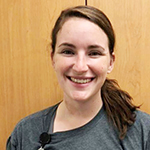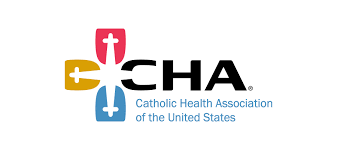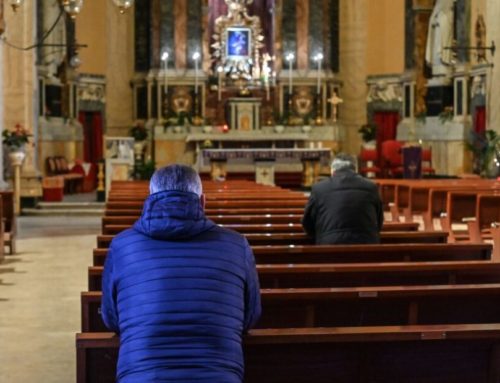ICU nurse soldiers on at South Dakota hospital in thick of COVID surge
November Online
Rising to the call
Nov. 30, 2020

Kehrwald
Shannon Kehrwald is seeing the devastation of the COVID-19 pandemic as an intensive care nurse at Avera McKennan Hospital and University Health Center in Sioux Falls. South Dakota has posted some of the highest rates of the coronavirus infection this fall. As of Nov. 24, the state was in the top five for cases per 100,000 residents in the last seven days, with 122, according to the Centers for Disease Control and Prevention. Nationally, that figure is 52. To meet the surge of critically ill patients, Avera McKennan has in recent weeks expanded its intensive care capacity to 40 beds from 24.
Kehrwald has been a nurse for five years, always working in ICUs. She spoke to Catholic Health World Associate Editor Lisa Eisenhauer on Nov. 23. These excerpts from her comments have been lightly edited for clarity.
We started seeing COVID patients, I want to say, right away in March. We did have a little bit of a surge in mid-April to the beginning of May, but now has definitely been the worst. Honestly, every day I go into work and it seems to have hit a little bit harder than the day before.
Within the last couple of weeks, we’ve had to take over more rooms in a different unit on a different floor. So that’s another challenge, that we’ve been learning how to work in a unit that is not necessarily designed to be an intensive care unit. They don’t have the same supplies as we have.
Just because we are creating more beds for patients doesn’t mean that we have access to extra medications or equipment or even medical staff. We’re doing everything we can, but we need the community to do their part too, such as wearing a mask, hand hygiene, social distance, stay home when you can, especially when you don’t feel well. I know it’s going to take all of us to overcome this pandemic. And hopefully people realize that it’s real and it’s not going anywhere anytime soon.
The majority of our patients in the ICU are COVID positive and are on COVID precautions, which means we have to wear N-95 masks and face shields with a gown and gloves, or we wear the (powered air purifying respirator) hood with the blower and a gown. After a certain amount of time in the hospital, our infectious disease doctors as well as other physicians can take the patients off precaution. Then we just have to wear a mask and face shield, but it takes quite a while to get to that point.
With COVID patients the common intervention is proning. That means we flip our patients onto their bellies to help their lungs expand, to get more air. This takes a lot of team members, respiratory therapists, multiple nurses, sometimes we have CRNAs in there. Our physicians have helped a time or two to get our patients onto their bellies because there are patients so critical.
We work 12 plus hours on our feet, running from patient to patient. Most days we don’t get a meal, let alone breaks to use the bathroom or get water.
I am pretty thankful to work with the team I work with. We communicate; we can vent to one another. It’s hard to bring that stuff home to families that don’t quite understand it.
Our patients aren’t able to have visitors if they are on COVID precautions. I do try my hardest to contact family at least once a shift to give them an update on what’s going on. We sometimes facilitate FaceTime or Zoom meetings. Their loved one is usually intubated, sedated, most oftentimes chemically paralyzed, so they aren’t able to interact. But it at least gives family members some peace of mind to see their loved one and know that we are doing everything in our power to help them get better.
A few of my family members have tested positive with COVID. It’s really challenging coming to work and seeing patients being my parents’ and my aunts’ and uncles’ ages and seeing how fast their health can deteriorate. It’s just really challenging to try to keep my mind on my patients instead of, “Oh no, what if my parents get it or if they get it this badly.”
This week I had a patient who’s been in the hospital since Halloween and he hasn’t been able to have any visitors and I discussed with the physician the length of time he’d been on the precautions. And finally, on Friday, his precautions were taken off. That meant he could have one visitor, so his son was able to come visit him. It was quite emotional for the patient, his son and myself, honestly, to be able to tell them the good news and be able to watch them see each other for the first time in three weeks. I was happy to see some joy in the hospital. A lot of our patients don’t leave the ICU healthily. The way that beds open up is if someone passes away.
My husband and I have practiced social distancing, the best that we can. We wear our masks. We utilize grocery pickup and things like that. A lot of my colleagues and I, after our shifts, we will change our clothes at the hospital. We don’t wear dirty scrubs in the car or into our homes and we toss them into the washing machine right away.
I do appreciate that we have the proper protective equipment at work, so we are able to keep ourselves safe. Sometimes I honestly feel safer at the hospital because I know that the people around me are wearing the proper equipment and utilizing the proper safety measures and doing hand hygiene, frequently wearing a mask.
My family and I have Zoom meetings once a week. It’s really a cup filler for me, just to talk to them about something other than COVID. My mom and my two sisters live three and a half hours away and I don’t travel up there right now.
One of my sisters found a Bible study and the four of us do that weekly, so we can be in touch with the scripture and talk to each other about it. That has honestly been my saving grace throughout the pandemic.
I can’t say I necessarily see light at the end of the tunnel for the COVID pandemic, but I see a light at the end of the tunnel for me, for a little bit. I am actually 34 weeks pregnant, so I have six weeks till maternity leave. There’ll be another human, but I won’t be overwhelmed at work and so I’ll get a little bit of a break. Unfortunately, my coworkers won’t.
My OB says as long as I’m wearing the proper protective equipment, I’m safe working with COVID patients. So, I probably will work up to as close as I can, especially since we are already short staffed and overworked. I don’t want to leave my coworkers with a heavier load than I already am, I guess.
My husband and I made 2020 a real big year. We got married, bought a house and are having a baby, all during a pandemic. After this year, I think everything will be a little more smooth sailing, hopefully.
Read more profiles in the Rising to the Call series.







